Sciatica Exercises: The 4 Best Exercises
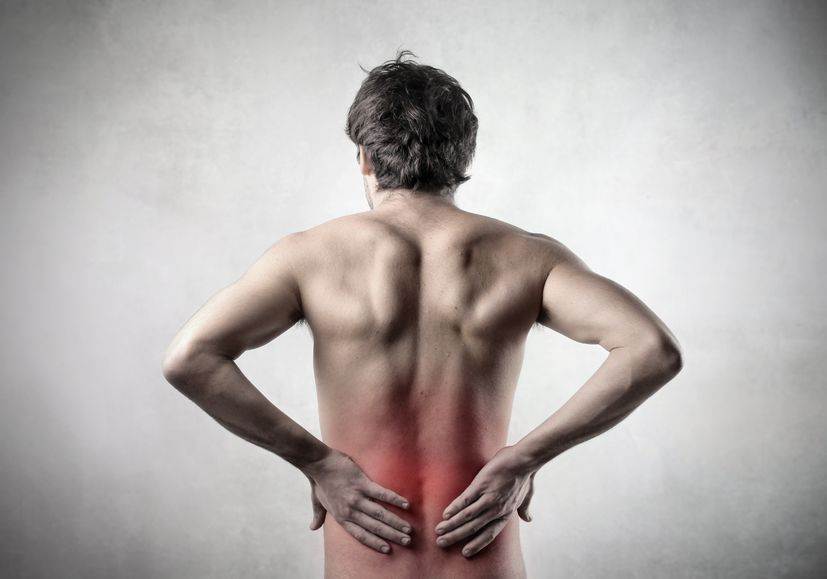
Discover the Best Sciatica Exercises for Pain Relief and Recovery
Persistent sciatica pain can transform daily activities into daunting tasks, leaving you searching for relief. If you’re on the hunt for effective strategies to alleviate sciatica and bolster your rehabilitation, welcome to your comprehensive guide. Here, we delve into not only the treatment options but also spotlight sciatica exercises that are crucial for pain relief and recovery. These exercises, when integrated with the professional care from your chiropractor or physiotherapist, are designed to reduce sciatica symptoms significantly.
Why Focus on Sciatica Exercises?
Exercises specifically tailored for sciatica play a pivotal role in managing and reducing pain. They are essential for strengthening the muscles supporting your spine, improving flexibility, and promoting healthy circulation to the affected nerve regions. This guide is your go-to resource for understanding how targeted exercises can complement medical treatments and accelerate your journey to relief and rehabilitation.
Understanding Sciatica: Sciatica Exercises
Sciatica is often described as a painful sensation that originates in the lower back or buttock, extending down through the thigh and leg, and occasionally reaching the foot. This discomfort results from the compression or irritation of the sciatic nerve. However, the root cause of this pinching can vary, necessitating precise diagnosis and tailored treatment plans.
The Complexity of Sciatica Causes: Sciatica Exercises
Identifying the exact source of sciatica is crucial, as nerve compression can occur at multiple points along its path. Misdiagnosis or oversimplification of your condition as merely “sciatica” without further investigation can lead to ineffective treatment strategies. It’s essential to understand whether the pain stems from issues like disc herniation, degenerative disc disease, or another underlying cause to ensure the appropriate therapeutic approach is employed.
See Also: Best Toronto Chiropractor: How To Find The Best Chiropractor In Your City
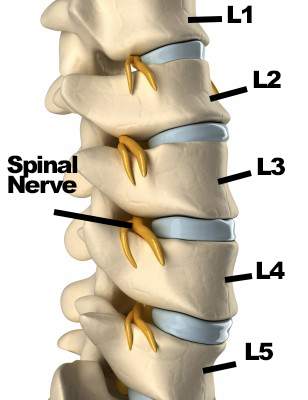
L4 and L5: Sciatica Exercises
So how do I know where my pinched nerve is? Two nerves come out between the last two vertebrae in your body. Your nerve is very commonly pinched here.
Your lower back vertebrae are called lumbar vertebrae. There are 5 vertebrae in the lower back. Taking the “L” for the lumbar spine, they are named L1, L2, L3, L4, and L5. The last two vertebrae in your lower back are L4 and L5.
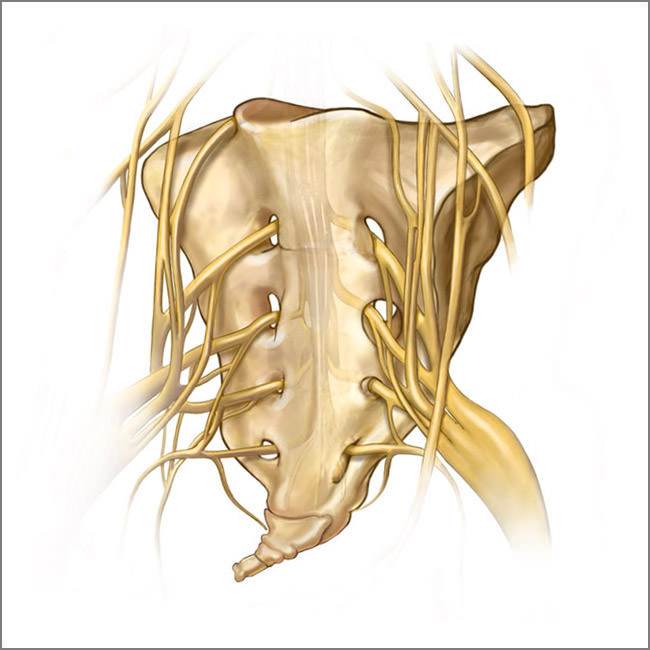
Ion medical designs http://www.ionmedicaldesigns.com/ion_site/two_dimensional_artwork.html
Just below L5 is one of your pelvic bones. It’s called the sacrum. The sacrum has holes with yellow-coloured nerves coming out.
S1, S2, S3: Sciatica Exercises
The nerves are called S1, S2 and S3. “S” is for sacrum. These nerves are rarely pinched.
Your sciatic nerve is formed when the nerves from L4 L5 and L5 S1 join together with the S1, S2 and S3 nerves in your buttock.
So, most of you will have your nerve pinched in one of three spots.
- In the buttock the Sciatic Nerve starts, in other words where the S1, S2, and S3 nerves join the two other nerves that come out between L4, L5 and L5 S1.
- Between L4 and L5 vertebrae
- Between L5 and S1 vertebrae
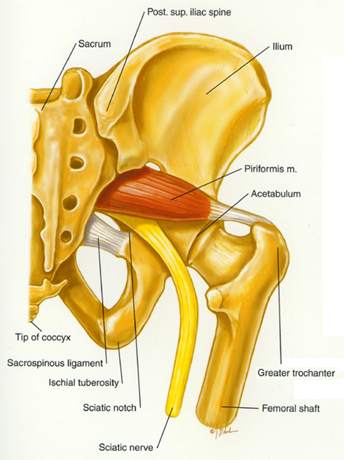
Now you know where the nerve can be pinched but it doesn’t answer why one of the nerves is pinched causing your sciatica
The Usual Suspects (Causes) of Sciatica
Most people’s sciatica is from:
- Herniated Disc at L45 or Herniated Disc at L5S1 (some osteoarthritis = “wear and tear” is involved)
- Degenerative Disc Disease (Osteoarthritis of the Disc=”Wear and Tear” of the Disc)
- Stenosis (Basically advanced osteoarthritis)
- Spondylolisthesis (A fracture of the vertebra or Osteoarthritis with the vertebra moving forward)
- Piriformis Syndrome
These are the diagnoses that your doctor or chiropractor should be telling you about not sciatica.
Remember sciatica only says that you have a pinched sciatic nerve causing pain in your buttock and leg, sciatica doesn’t tell you the cause of your pain. Without determining the cause you will get hit-or-miss treatments from your chiropractor or physiotherapist as they can’t give you specific treatment.
See Also: MRI CT scans X-rays, What’s Best For My Pain
The key exam that you need to determine what the heck is causing your pain is a neurological examination. You have probably seen it on TV before.
- Reflex tests with a reflex hammer on your knee and the back of your ankle
- Muscle Strength Testing: Resisted muscle testing of your foot. You try and push up/down while the chiropractor holds your foot. An alternative is heel walking and walking on your toes.
- Light Touch and Sharp Dull Testing: A light touch directly on the unclothed legs and feet to determine if you are unequal in your sensitivity to light touch and sharp/dull testing. A light touch is often enough as a screening.
Also, remember that the diagnosis should pretty much be determined in the office and X-rays, MRI, and CT scans done only if there are signs of something else or the diagnosis is kind of fuzzy.
See Also: Herniated Disc Part 2: The Best Exercises For Your Herniated Disc
Herniated Disc: Sciatica Exercises
You herniate a disc from the everyday habits that you have. The everyday habits of slouching and bending with a rounded low back, build up to weaken and damage the disc to the point it is ready to break open and herniate.
The problem is there is no pain. You don’t feel sciatica until the disc has herniated as there are no nerves inside the disc. So you continue your habits and think you don’t have a bad back until one day you lift your daughter off the floor.
The only problem is you had a bad back with no symptoms for a very long time. This is just like a car with a little bit of rust showing but if you take the car apart you see a lot more rust.
Degenerative Disc Disease – Osteoarthritis of the Disc
Degenerative Disc Disease is a continuation of the breakdown of the disc that was started by bad lifting and slouching habits.
The disc becomes smaller, and brittle like an old elastic band that is decaying, leading to the disc becoming smaller in height. The smaller disc makes the space between the vertebrae smaller. Thus, your nerve doesn’t have much room, so your nerve gets pinched between L4 and L5 or L5 and S1.
Stenosis- Most commonly from continuation of Osteoarthritis
Stenosis is a “narrowing”. There are two types of stenosis
- Lateral Stenosis
- Spinal Stenosis
1. Lateral Stenosis is the narrowing of the hole which the nerves from the spinal cord come from. Does this sound familiar? It’s degenerative disc disease + the bone degenerating forming spurs that narrow the hole for the nerve. A smaller hole for your nerve eventually means a pinched nerve.
2. Spinal Stenosis is the narrowing of the canal where the spinal cord sits. This is essentially pinching of the spinal cord usually in the lower back.
Spondylolisthesis (Vertebebra moving forward)
Spondylolisthesis is usually the moving forward of the vertebra (sometimes backwards). When the vertebra moves forward the spinal cord and nerves are pulled putting tension on your nerve. Nerves under tension get irritated and so turn into sciatica. This can happen from a fracture to the vertebrae or osteoarthritis.
Piriformis Syndrome
Most people’s sciatic nerve usually goes over or under the piriformis muscle. In some cases, possibly yours, the sciatic nerve goes right through the piriformis muscle. When the muscle tightens up it squeezes on the sciatic nerve causing sciatica.
Walking like a “man” is another reason for sciatica. That’s right, when you walk bow-legged with your feet turned can give you trouble later.
Chances are, if you are reading this you already have a problem with sciatica. When you turn your feet out this makes the piriformis muscles work harder.
The harder your piriformis works the more likely the nerve will be pinched causing sciatica.
The 4 Best Exercises For Sciatica
While treatments are different for sciatica depending on the cause you can still help your chiropractor or physiotherapist by doing your home exercises.
1. Flossing: first introduced by Michael Shacklock
Flossing is good for your teeth but a different kind of flossing is good for your spine and spinal hygiene.
First, determine if you can floss safely:
- Sit on a chair or relatively hard surface. Please don’t sit on the couch, it is too soft and will aggravate your lower back.
- Raise your painful leg to the point of pain and keep it there.
- Bend your neck forward till your pain is aggravated from above
- Lower the leg till the pain decreases.
If the pain decreases you are safe to do flossing.
Warning: This exercise can cause acute sciatica but chances are minimized by doing the screening exercise. Don’t floss until you have been out of bed for at least 2 hours. Now The Flossing:
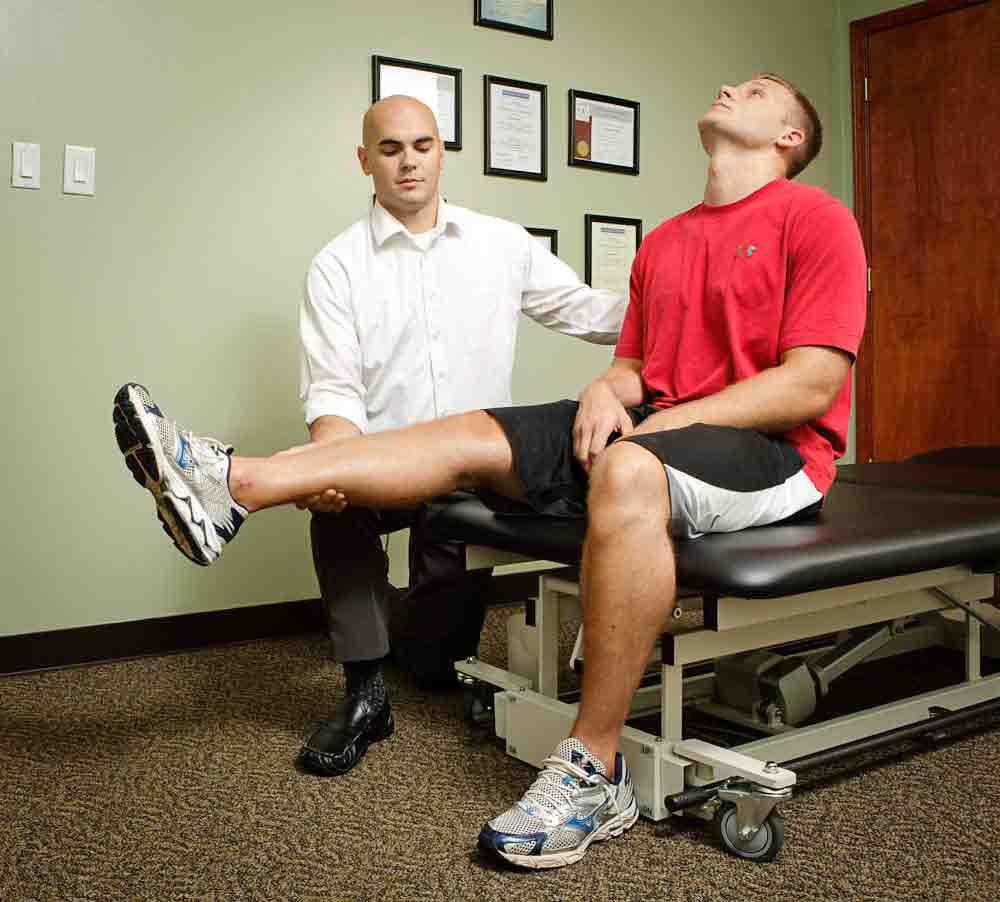
- Sit down in a chair with your legs swinging freely
- Bend your neck forward for 5 seconds (if this doesn’t cause sciatica you can do the next step)
- Bend your neck backwards as far as possible and straighten the knee (5 seconds)
- Repeat 3 sets of 10X on each leg. You can do this for up to 5/day.
2. Piriformis Stretch A) Sitting and B) Lying Face-Up
A: Sitting:
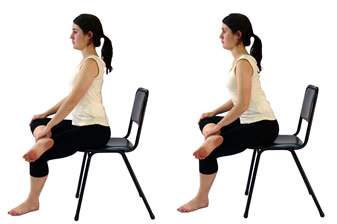
- Sit in a chair and cross the bad leg over the good
- Keep the arch in your back and move your chest forward
- Repeat 3 sets 30 secs. This can be done several times a day
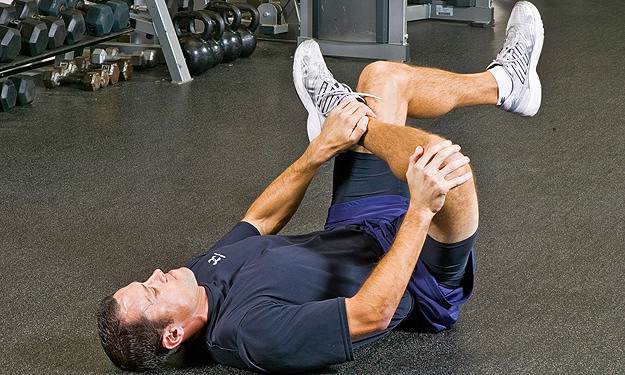
B: Lying Face-up: This exercise might be easier for some of you.
- Lying Face-up both knees bent. Put the bad leg over the good.
- Bring the good leg up to support the bad leg.
- Push the bad leg outward.
3. Ball Exercises: Piriformis, Gluteus Maximus, Gluteus Medius
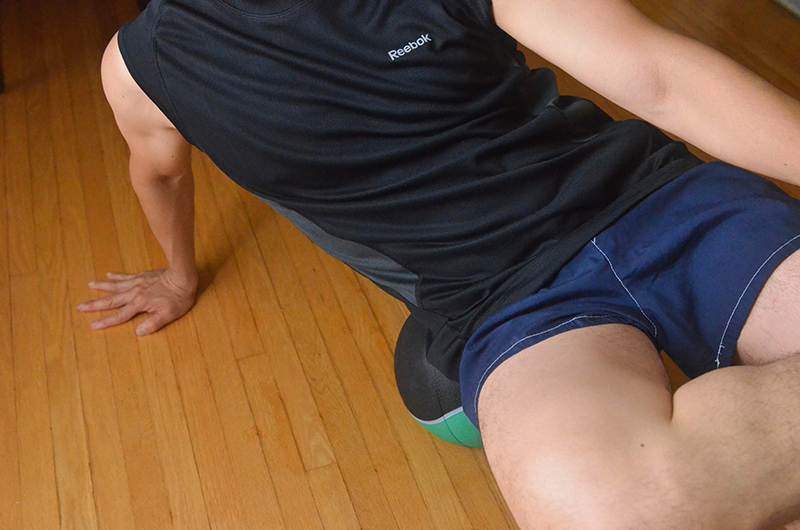
Piriformis
- Cross your bad side leg over the other knee
- Get a tennis ball, basketball or a medicine ball and sit on it with your buttock.
- To treat the piriformis go lean at about a 45-degree angle.
- Stop at each tender point and hold until each one is ironed out or feels less tender.
Gluteus Maximus
- Same as the piriformis except that you don’t need to cross the bad over the good.
Gluteus Medius
- Same as Gluteus Maximus except that you now lean at almost a 90-degree angle -You are almost on your side with a focus on the side area just below the belt or hip bone
4. Cobra
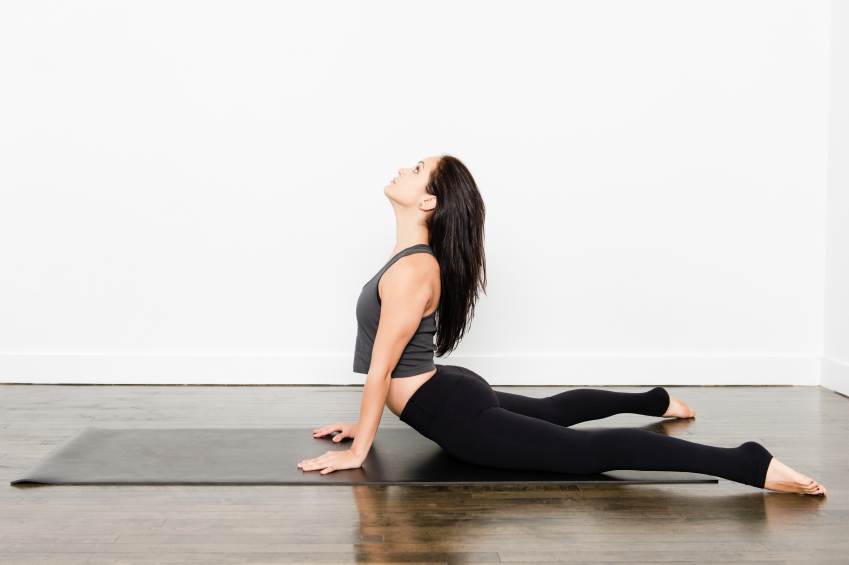
- Lie down face down with your hands underneath your shoulders.
- Push up from as high as you can until your lower back stops you or your elbows are straight.
- The pelvis should still be on the floor and the lower back muscles relaxed.
- Do these exercises hold each time for 1-2 seconds 6-8 times per set? This exercise can be repeated every two hours throughout the day.
If your pain is from a disc herniation you can combine the disc herniations part 2 exercises with these exercises. If your sciatica is from a different cause I will write about all the conditions that cause sciatica over time.
Write in the comments to tell us how you are doing with your sciatica. Also, let us know your vote for the best Toronto Chiropractor below. Connect with me on LinkedIn.
Related Categories: Disc Herniation, Elbow, Hip, Low Back Pain, Shoulder, Stenosis



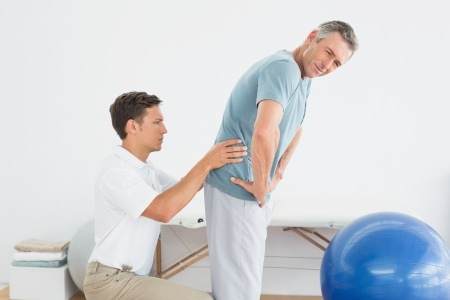
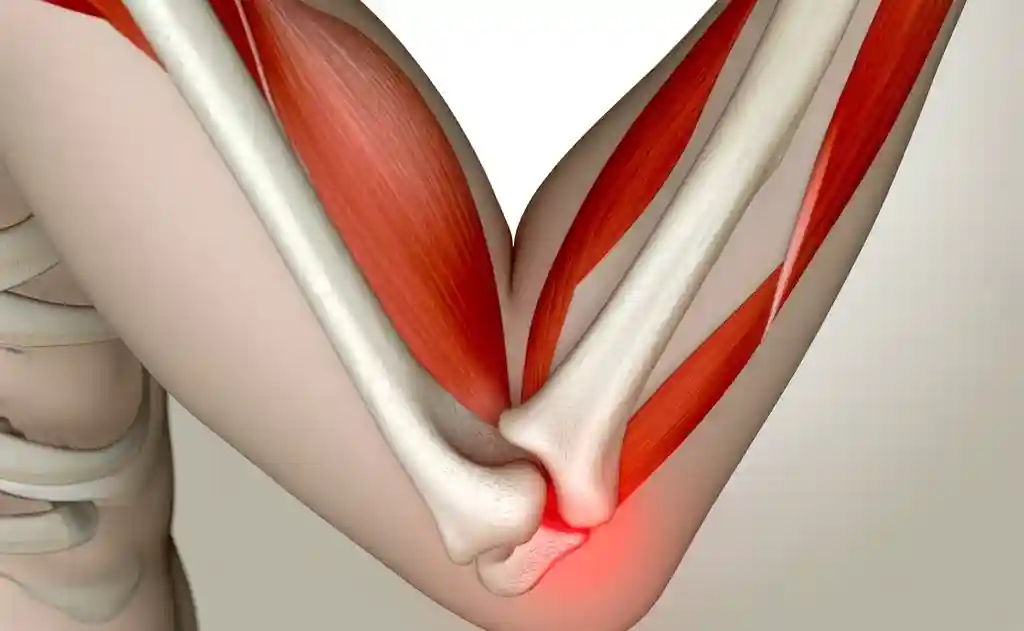
Dear dr. Ken Nakumara,
I have most probably had a herniated disc (l5 s1) for almost 2 years with slight constant sciatica reaching not further then my buttocks. The last 7 months the sciatica got worse and worse untill it reached my toes and i could not do anything without excruciating nerve pain. I have been placed on the waitinglist for surgery. While in so much pain and waiting I have started doing every possible thing to minimize the pain (improved posture, no more lifting or bending, physiotherapy, non inflammatory diet, rest and taking PalmitoylEthanolAmide (PEA) and of course other painkillers such as paracetamol) All of which helped up till the point I no longer take ‘regular’ painkillers. The nerve pain in my leg left and I was left with only nerve pain in my foot (which fluctuates with how much I aggravate my back). My question is as followed; since the intense nerve pain started months ago it has also come with numbness in my foot and calf, which also varies in intensity from day to day. I worry that the PEA is ‘muting the pain’ and I am damaging my nerves, what is your opinion on this? If I was certain that this was not the case I might opt out of surgery now that my sciatica seems manageable, which is again something I cannot find any clear information about, am I just avoiding the inevitable by leaving my huge disc bulge intact and fighting symptoms? Of course I know you cannot offer any conclusive answer, but any opinion or advice you may want to share is very welcome. Thank you in advance.
Author
Thanks for your question Leonie. Sound like you are from the UK. Sorry to hear that you have suffered such a long time. Your disc is pinching the nerve but the nerves can recover at this point. It is always better to have less pressure on the nerves rather than more. So yes for example you could sit too long and make the disc come out more and pinch the nerves even more and not know that you are doing that. Having said that you will know if you have done too much if you have trouble straightening up from bending or sitting. A more important sign you shouldn’t ignore is if you have drop foot that is getting worse or pain, numbness or tingling around the groin and the inside of your thighs where a saddle would touch, if you were to ride on a horse. This is called saddle anaesthesia and is a sign that your disc may be causing too much pressure and will need immediate surgery. Another sign is if you have trouble initiating urination or become very constipated.
Hope that helps your sciatica.
Hi Doctor,
I have an L5 S1 Disc herination (discal extrusion mentioned in my MRI : 17×11 mm obliterating the ventral aspect of thecal sac and severly compromising the right exit path way).
Doctor has prescribed with 5 sessions of Physio, Pain in leg happens 2-3 times a day, and i am able to walk & swim) should i continue the physio, since i am afraid about surgery.
Author
Thanks for your question. Provided that the diagnosis is correct then you should continue the physio sessions. However expecting your physiotherapist to get you better in 5 sessions is not reasonable. Your doctor is way out of line if the diagnosis is correct. Disc extrusions will take months to get better if they get better at all.
Hope that helps your sciatica.
Hi Dr Ken,
Thanks for you post which made aware of Sciatica pain. This is Sri, 28Years Male.
I would request an help from you that i gone for MRI scanning and it showed up L5-S1 left is moderately compressing.
When i contacted Nero Surgeon in my location, he told i may have to go for Microdiscectomy surgery. I’m not able to walk for more 15 mins, nerves in my right thigh are irritating me and also not able to bend. Apart from all these, I’m getting testicular pain but report is normal when gone Scrotum and abdominal scanning.
Could you please suggest me on this?
Thanks in Advance
Sri
Author
Thanks for your question Sri. I cannot recommend any exercises at this time as the exercises have a good chance of making you worse. If you were here with me I could tell you when to start and when to stop and try a set of exercises. That would be in a more controlled setting where I can monitor your symptoms. I cannot do this over the internet with your case being near the danger zone. Whenever you have testicular pain or scrotal pain that is related to the lower back that is a red flag. If the two are actually related then if it starts making you lose bowel function or cannot or have trouble initiating urination then you have an emergency situation where you need immediate surgery.
You need to go back to your medical doctor if the two symptoms are related.
Hope that helps your sciatica.
Thanks a lot Dr Ken for your reply!!
I have consulted my doctor as per your suggestion. They told sometimes it may radiate pain to testicles too.
And They left decision to me, if i want to go for surgery now or later. Head of the department suggested surgery not require at this age, it may recover automatically if i take some rest. I’m in dilemma what i should do now.
Can you please confirm if this L5-S1 nerve compression can causes testicular pain?
Thanks in Advance!!!
Sri
Author
Thanks for your question Sri. To answer your question yes, testicular pain can be caused by disc herniations. That was the reason for the concern and why I recommended that you go back to your doctor to confirm that these are the same problem, the disc herniation causing testicular pain. You can try doing the exercises here. https://www.bodiempowerment.com/herniated-disc-part-2-the-best-exercises-for-your-herniated-disc/
However you do have a high risk of getting worse. You cannot do these exercises unsupervised. If you do, you have a risk of causing yourself more harm. They need to be supervised by a chiropractor or physiotherapist familiar with these exercises.
Hope that helps your sciatica.
Hello Dr Ken,
Hope you are doing good!!!
After I tried rest, physical therapy my lower back has not gone. So I had L5-s1 fusion surgery on September 1st 2016, I’m 28 years old. After surgery there was full discharge coming out from the wound, after one month I got severe shock pains, not able to get up from bed. When I checked with doctor he noticed small fluid collection around screws in MRI. I’m prescribed to take antibiotics(linezolid and Duonem-ER) for totally 8 weeks, still I’m suffering with pains, not able to walk till washroom. My surgeon is telling it will be reduced and nothing much is there to open and clean it, but I don’t see any improvement.
Can you please help and guide me heread.
I’m getting doubt whether I will get recover or not 🙁
Writting you this text with some hope……
Thanks in advance!!!
Author
Thanks for your question Srini. With the type of surgery you had this makes normal exercises extremely difficult. I cannot help you as you will need specific exercises from someone that can examine you.
Good luck with your post-surgical recovery from L5-S1 fusion surgery.
Dr. Ken, I had nerve shivering on my both legs below buttocks for 7 days before one month. This symptom reduced gradually over the time, but still i have some uneasiness on my leg especially while walking. I have consulted neurologist and undergone MRI. The report says, Diffuse disc bulge is seen at L4-L5 level indenting the theca causing bilateral mild neural foraminal stenosis, the dics is impinging the bilateral exiting L4 nerve roots. And diffuse disc bulge is seen at the L5-S1 level indenting the theca causing bilateral mild neural foraminal stenosis. impinging the bilateral exiting L5 nerve roots. No significant spinal canal stenosis is seen.
Please advise A. what physiotherpy excercise shall i do? B. Can i continue my job which is mostly sitting in office? C. Can i continue my walking, swimming as usual? Looking for your kind response.
Author
Thanks for your question SS. First your problem of shaking legs can be due to the disc it’s true. However a lot of other things can cause shaking or “shivering” of the legs. You can try these exercises. https://www.bodiempowerment.com/herniated-disc-part-2-the-best-exercises-for-your-herniated-disc/
However your symptoms are not usual so the exercises must be supervised by a health professional familiar with the exercises. Medical doctors don’t have the back ground. It’s either a chiropractor or physiotherapist.
Thanks doctor for your kind response.
Author
You are welcome Marimuthu.
Hi, Dr. Ken. Already this site is 100 times better than other misinformation out there. I was diagnosed (an MRI) with mild osteoarthritis, although I feel they were fishing for an explanation to justify my pain for the last 3 years. I’m 58 so, oh, that must be the problem. My back doesn’t hurt unless bending backwards on purpose or climbing stairs, but mostly the pain is in my right calf and legs, especially when lifting something like two bags of groceries. I was doing those bootcamp type video exercises around the time the paid started, if that helps. Do all of these exercises apply to me? Pain seems to subside when I am working out, not sedentary. Chiropractor was okay, but no visible improvement so i stopped going. Thanks in advance for any advice.
Author
Thanks for your question Courtney. You should try these exercises. https://www.bodiempowerment.com/herniated-disc-part-2-the-best-exercises-for-your-herniated-disc/
Like any exercises though they can make you worse. They should be supervised by health professional who is familiar with the exercises. If the pain, numbness or tingling goes further down into the leg than you are getting worse so should stop right away.
Hope that helps your sciatica.
hello doctor i’m fouzi i have sent you a message a month and a half ago about my back injury l4l5 disk herniation i’m now pain free thnx god i was suffering from sciatica but now i’m also pain free and i’m a bodybuilder love to train ….i just started trainingand when i do pull ups i feel something i can’t explain how it is like the muscles are tite in the back area in the lumbar or the spine is compressed strange feeling but i managed to do them then i tried dips and here i couldn’t cuz i was affraid that something happens when i do them so i stopped its like something is pulling my back and keep in mind there is no problem with doing daily activities i mean pain free …. what should u recommand doctor and should i get back training but only when my back is on the floor i mean benching and triceps bar and incline press things like that i dont do squates and deads at all i don’t wanna put pressure on the spine yet cuz i want to make sur that the disk is healed …. thnx doctor any advice from you would be great … i’m from algeria and now peaple from here start to read and follow your facebook page and other articles … you are the best doctor … thnx
Author
Thanks for your question Fouzi. Welcome the people of Algeria. You are all welcome. I am very happy the you are pain-free with regards to your sciatica. The tight feeling if it while you are hanging from the pull up is simply traction on your spine. It would be perfectly fine to do pull-up but you have to make sure you don’t jump down. Make sure you can place your feet down not land hard on your feet. If you land hard your disc will be aggravated.
Hope that helps your fears of re-aggravating your sciatica.
Hi I have two much pain in my low back pain and also pain in my legs I done MRI report report says bony spine is intact with no evidence of fracture listhesis or marrow abnormality.normal lumber lordotic curvature is noted spinal canal is ample and no evidence of spinal canal stenosis throughout lumbar region is observed.at L5-S1 level para central centrally protruded disc (protrusion of 4.5 mm) is noted with tiny central annular tear projecting left laterally causing mild ventral thecal sac compression &cleft foraminal encroachment all other lumber disc &disc spaces have normal mr signal and are well preserved no frank herniated disc throughout lumber region is seen no evidence of intra or extra dural abnormal MR signal is noted and conus medullaris cauda equina & nerve have normal MR signal no pre or para vertebral soft tissue mass.
Impression
Mild degree degenerative discogenic changes L5 -S1 disc. No frank herniated disc or spinal canal stenosis throughout lumber area
Noted.lumbosacral junction all vertebra may be transitional in significant number of cases therefore vertebral levels must be correlated with plain radiographs / fluoroscopy prior to any intervention
Author
Thanks for your question Salah. Your radiologist is mixed up. He says there is a centrally protruded disc of 4.5mm then he/she says there is frank herniated disc. Well it doesn’t get more “Frank” than that. Especially when there is thecal sac compression. Hope your medical doctor and those who are caring for you actually read it. Like I said your radiologist is mixed and if your doctor doesn’t read it carefully your doctor will say there is nothing wrong.
Time to talk your doctors again. Hope that helps your sciatica.
Dr Ken,
Thank you for your wonderful service via this website. I am male 33 years old. For the past month of so i developed a back ache. I went to the doctor and after physical examinations he concluded that I have a muscle tear from dead lifting at the gym however I insisted on an MRI and went ahead with it. My MRI report states everything is Fine including ” NO DISC PROTRUSION OR HERNIATION IS SEEN IN SPINAL CANAL”. However, what’s written in bold on the reports says” Disc dessicatory changes with schmorl nodes & early marginal ostephyte formation is noted at D10-11 & D11-12 levels causing thecal sac indentation. Lateral recesses are fairly preserved and no exiting roots compression is noted”
My doctor says its normal symptom for guys in my age specially since i sit at the office for long hours and lift weights at the gym. I still have pain which tends to travel to my upper back back but mostly resides in my lower spine just above the buttocks. I am doing most of the exercises mentioned above prior to my work out but my pain tend to come and go. I had to quit my early morning jog because i felt it elevated the pain. So am I suffering from Sciatica and should i give up on my workout despite not even being a heavy lifter or is this just from of Muscle Pain or Spasm ? Thank you for your kind response in advance
Author
Thanks for your question Shahbaz. Almost always the back problem isn’t a muscle problems. Yes muscles are always affected but rarely the cause. Muscles are treated to help the symptoms but until the cause is address the problem will stay. ASK YOUR DOCTOR WHICH MUSCLES? I doubt he/she could instantly tell you without looking up, down or sideways.
Dead lifting is terrible for the back. I wouldn’t recommend it, unless you are perfect at it. So far i have only seen on person do it right, even with personal trainers. You should modify your work out to no lifting and stick with light cardio for now such as the eliptical. Even biceps curls and chest work with dumbells bent over will be bad for your back. Basically anything with flexion. Concentrate on getting better not working out is even better. Work only on the exercises that will get you better. This way you know you aren’t undoing all the good.
Try these exercises https://www.bodiempowerment.com/herniated-disc-part-2-the-best-exercises-for-your-herniated-disc/
If the pain, numbness or tingling goes further down the leg you should stop the exercises. These exercises should be supervised by health professional.
Thank you very much for your kind response. Will do as instructed.
Author
You are welcome Shahbaz. Hope your sciatica improves.
Dr. Ken, Thanks for the great site and all your information. I would like your opinion of my situation. I was suffering from Sciatica pain in my left leg (burning from thigh down with some tingling in my foot). I went to a chiropractor who did a diagnosis and x-ray. I was started on a regular course of adjustments which in the last month have reduced my pain dramatically. He also requested a MRI which revealed L4-L5 disc bulge with facet joint enlargement. L5-S1: The intervertebral disc is uncovered with disc material seen extruding superiorly above the level of the disc space. The facet joints are enlarged. The spinal canal is not affected. There is moderate posterior bilateral neural foraminal narrowing which is secondary to disc material as well as the aforementioned anterolisthesis.
After seeing the results the doctor recommend laser enhanced spinal decompression and provided one trial session (It is the Hill labs decompression table). The treatment in addition to the ongoing adjustments and lumbar traction is 20 decompression sessions at an additional cost of $1800.
My question is this decompression necessary to heal my disc? My doctor even stated my regular therapy could achieve the same results but take much longer. I have researched this decompression therapy and have not found any scientific results, but only negative stories about false claims and the FDA coming down on companies making these claims. Will your disc herniation exercises eventually achieve the same results? Is there any benefit in any of the inversion tables to hang by your feet? Other than an MRI is there any way to determine my disc recovery status?
BTW (I passed the flossing test and just started your herniated disc part 2 exercises)
Thanks in advance for all your help.
Carl
Author
Thanks for your question Carl. If I were you I would start with the exercises. If doesn’t take longer in fact you should start improving before you could finish 20 decompression sessions. You can get great results because you can do the exercises in most places, I have some doing them at work.
Don’t go by MRI for recovery. Even after recovery most people have some discs still sticking out. Go by your symptoms. Most disc herniations do not require an MRI to begin with. You must be in the US, Australia or the UK. Where there is private care you will get more care.
Hope that helps your disc herniation.
Hello Sir, would you recommend swimming as a form of helping the spine with an L4-5 right side herniation with congenital stenosis, and if so what stroke is best? Thank you.
Author
Thanks for your question CM. It really depends what is causing your symptoms. If the disc herniation is causing your pain than it’s the breast stroke. If the stenosis is causing your pain then do the front crawl.
Hope that helps your sciatica.
Hello sir, ur website is very helpful.. I am from India.I am 22 years old and a graduationstudent. I am suffering with pain in back and left leg from 11 months. My MRI report says ” broad-based posterior disc bulge with prosperity towards the left paracentral region causing compression over the thecal sac and narrowing of bilateral neural foramen (left>right) at L5-S1 intervertebral disc level”. I have been suggested spine extension exercise. I am feeling comfortable after doing exercise. But sometimes it pains too much.. I cannot raise my left leg completely. It seems that my backbone in not in normal position and it has bent.. Plz suggest me something to overcome with it..
Author
Thanks for your question Satyam. You can do these exercises https://www.bodiempowerment.com/herniated-disc-part-2-the-best-exercises-for-your-herniated-disc/.
However you are likely to get worse without customization of the exercises. Best to find the best physiotherapist or best chiropractor in your area that are familiar with the exercises.
Hope that helps your sciatica and lower back pain. Bye from Toronto
Hi , I just diagnosed with l5 s1 lateral resess neural foramina. Since 1 month having huge pain in buttocks and too much pain . Can you please suggest some excersise and best way to get relief. Thanks in advance
Author
Thanks for your question Sandhya. All of the exercises I have on the blog will likely make you worse. You will need guidance from a chiropractor or physiotherapist as the exercises need to be specific to your lower back.
Hope that helps your possible disc herniation.
Sir i am having disc herniation at l5 s1 recently and can walk but some time with intense walk and climbing on stairs makes my culf pain ful and for last two days my right feel is partily numb…kindlay suggest some excercise
Author
Thanks for your question Jibran. You have to give me detailed symptoms before I can help.
Hope you understand that i need more information about your possible disc herniation.
Hi Dr! I haven’t seen a chiropractor. But I had a massage this weekend & saw my Osteopath. I’ve some nerve pain when I sit (rt side). Massage helped. My psoas was quite tight, shortened & ropey. We are working on it. When I walk for extended time my quad tightens. I use a roller & do your exercises. My piraformis quite tight & discomfort from my back radiates there & outer hip. Its improved w/exercises. I’m hoping its just pinched & resolvable????
Author
Thanks for your question Laura. Sound like these exercises may be helpful for you. https://www.bodiempowerment.com/herniated-disc-part-2-the-best-exercises-for-your-herniated-disc/
If the exercises increase your pain or give you symptoms further down the leg like numbness, tingling or pain than you should stop the exercises. These exercises should be supervised by a health professional.
Hope that helps your sciatica.
I am 38 years old. I have been dealing with pain in the outer area of my right calf muscle. It has been at least a year that I have been dealing with it. I have been to orthopedic who sent me to physical therapy because he thought it was related to knee problems. PT thought it was related to my sciatic nerve. So I went through pt and sent on my way with advice to return to orthopedic if pain returned. It did so I went back in and orthopedic basically said he would do mri of back then send me to pain management. I got second opinion because I also have a lipoma located just below the calf muscle with the pain. I went to chiropractor who discovered a bone out of place in my ankle. This helped relieve some of the pain. I went to second orthopedic and he said sciatic nerve also and sent me for lumbar mri. Results:
L1-L2 normal, L2-L3 normal, L3-L4 disc space height maintained. minimal circumferential disc bulge. there is mild left, no signiificant right foraminal stenosis. no definite nerve root impingement. no significant canal stenosis. there is mild facet hypertrophy, L4-L5 disc space height maintained. mild circumferential disc bulge. mild effacement of the ventral thecal sac without significant canal stenosis. mild bilateral neural foraminal stenosis. no definite nerve root impingement. there is mild facet hypertrophy. L5-S1 low T2 disc signal and mild disc space narrowing there is a mild circumferential disc bulge. superimposed small protrusion in the right paracentral region measuring 9mm transverse, 3mm in AP dimension. there is mild right lateral recess stenosis. protrusion approaches the descending right S1 nerve root without definite contact. Moderate bilateral neural foraminal stenosis. no significant canal stenosis overall.
After these results, I was told to see a pain management doctor to get spinal injections. My concerns are starting injections now will I have to continue through my life? What exercises and things should I avoid? Can I get improvements with my bulges if I loose weight, do stretches, strengthening exercises, and inversion table? Should I see chiropractor or spine specialist? When I asked all these questions at orthopedic the answer was we don’t do backs go see pain management doctor. I requested if I could go to pt and get some answers to what I can and can’t do. I just feel like I am not getting any answers to my concerns. I would love some feedback. Thank you!
Author
Thanks for your question Amy. A good chiropractor or physiotherapist can answer your questions. Assuming the disc is causing your pain which is questionable but definitely possible you can do these exercises. https://www.bodiempowerment.com/herniated-disc-part-2-the-best-exercises-for-your-herniated-disc/#comment-5333
If the pain gets worse or symptoms go further down the leg like numbness, tingling or pain then you should stop the exercises. These exercises should be supervised by a chiropractor or physiotherapist.
Losing weight helps but won’t cure your problem. https://www.bodiempowerment.com/disc-herniation-part-1/. Assuming it’s a disc problem you can stop aggravating your disc by reading this article.
Hope that helps your possible disc herniation.
Hello again,
I had an MRI done 3.5 years ago and wanted to share my results so you could get a full picture.
L3-4: There is a 2mm diffuse disc bulge and mild facet arthropathy. There is a mild narrowing of the central canal. The foramina are adequately patent.
L4-5: There is a 3mm broad-based disc protrusion with an associated annular fissure. There is mild facet arthropathy and thickening of the ligamentum flavum. There is mild narrowing of the central canal and lateral recesses, and there is mild foraminal narrowing bilaterally.
L5-S1: There is a 3-4 mm broad-based disc protrusion and there is mild facet arthropathy. No significant central canal narrowing. There is mild to moderate narrowing of the left lateral recess and mild narrowing of the right lateral recess with minimal encroachment on the traversing S1 nerve roots. There is moderate foraminal narrowing on the left and mild to moderate foraminal narrowing on the right.
The paravertebral musculature is within normal limits.
I have seen 4 chiropractors and all of them tell me that it isn’t so bad. So why is pain getting worse and I started getting a sciatica, which I have never experienced prior to last year.
Please shed some light on my case.
Good evening Doc,
I get a reoccurring sciatica due to disc herniation. To be more precise, currently I am going through my second sciatica episode.
I have experienced my first sciatica in March of 2015. I stopped exercising, got depressed, gained 35lbs in less than a year. Prior to that, I was a very active person and in great shape.
As of last month I got back into indoor spinning 5 times per week. Unfortunately, the sciatica kicked in again earlier this week. Do I fight the pain and keep on spinning/cycling or will it aggravate the nerve and make it worse?
Your advice would be greatly appreciated it.
Hi Doc
Love your site, I have had 2 Micro disectomy, laminectomy on l4/l5 for a disc that herniated and re herniated. All was well for a few weeks and now sciatica pain. Updated Mri shows my vertebra, disc are not in alignment and is impinging a nerve.
Had a cortisone shot today and hoping to avoid the inevitable diagnosis from 3 doctors that at some point I will need a spinal fusion due to the continuing wear and tear.
I used to do monthly chiropractor adjustments but had to stop for last 8 weeks or so. In want to red star them and curious on whether you feel adjustments along with exercise and I love the ones you show would make a good course of action to try.
I am 48 and have had back pain for about 5 years but to be honest trying to hold off on spinal fusion as I just feel like I am too young.
Very interested in your thoughts, suggestions.
Author
Thanks for your question Jeremy. Why don’t try another chiropractor or a physiotherapist in your area that may be able to help. You’ve had a lot of surgeries and haven’t healed fully from the them if you had your last surgery a few weeks ago. Not sure what you mean by “vertebra, disc are not in alignment”. Do you mean spondylolisthesis? Did they tell you the risks of surgery?
You could try these exercises. https://www.bodiempowerment.com/herniated-disc-part-2-the-best-exercises-for-your-herniated-disc/.
However especially your case exercises can make you worse. You need to have them supervised by a health professional like a chiropractor that knows about disc hernaitions and how to treat them. A chiropractor or physiotherapist would be one of them.
Hope that helps your disc herniation.
thnx for your reply doctor i will try them for sure
Author
You are welcome Fourzi.
thnx for your reply doctor ….the pain started first about 3 monthes ago and i thought it’s just a muscle sorness and i continued to lift heavy then after weeks the pain gets worst and worst every day to the point i couldn’t walk and tie my shoes especially when i wake up in the morning then i stopped training now for 25 days the pain is not as much as it used to be but still have problems in the very morning when waking up and after may be just 1 hours it’ll go away and i’m pain free the rest of the day till the next morning ….the question is i’m i in the right direction of healing ? i can do any type of meckenzie exercice without sore what do you recommand best in such exercices ? last question dear doctor do pull ups relief or aggravates this condition ? thnx doctor for your generous reply and have a good day sir
Author
Thanks for your question Fouzi. You are going in the right direction if you are only having morning pain. Your should do the exercises also. https://www.bodiempowerment.com/herniated-disc-part-2-the-best-exercises-for-your-herniated-disc/
Pulls up won’t aggravate your pain unless you land hard on your feet. Just put a stool underneath if there is any type of drop from the chin up position to the floor.
Hope that helps your sciatica.
Hi Ive had minor pain in lower back and left leg starting 6 months ago after heavy lifting. The fist month was really bad and after that it was much better. The leg pain is almost completely gone, however I still get minor pain in lower back around L5, slightly to the left side. I had an MRI but it was very late around 4 months later and it didn’t show any abnormality with the discs. Everything appeared fine. However my physiotherapist and doctor are certain that its a minor bulge on the posterior left side of the dics between L5 and S1. I can do all my normal activities and never have to take pain killers on 95% of days, however sitting and sleeping on my bed aggravates it, not to a serious extent but enough for me to be aware of it. Its annoying and distracting but not unbearable. My question is: is my current state the maximum recovery I will make or can bulging discs heal further even after 7 months and if so what excessive would you recommend I am able to do any movements without pain on most days. Unfortunately I only started physio just now as it wasn’t that bad and healing fine until last month after which I haven’t experienced any further improvements and thats worrying me.
Author
Thanks for your question Ahmed. Your physio or chiropractor has to show you exercises for return to function. However without an examination I won’t be able to tell you what exercises. It’s up to your physiotherapist to know the correct exercises.
Glad your sciatica is now better and hope your lower back pain gets better too.